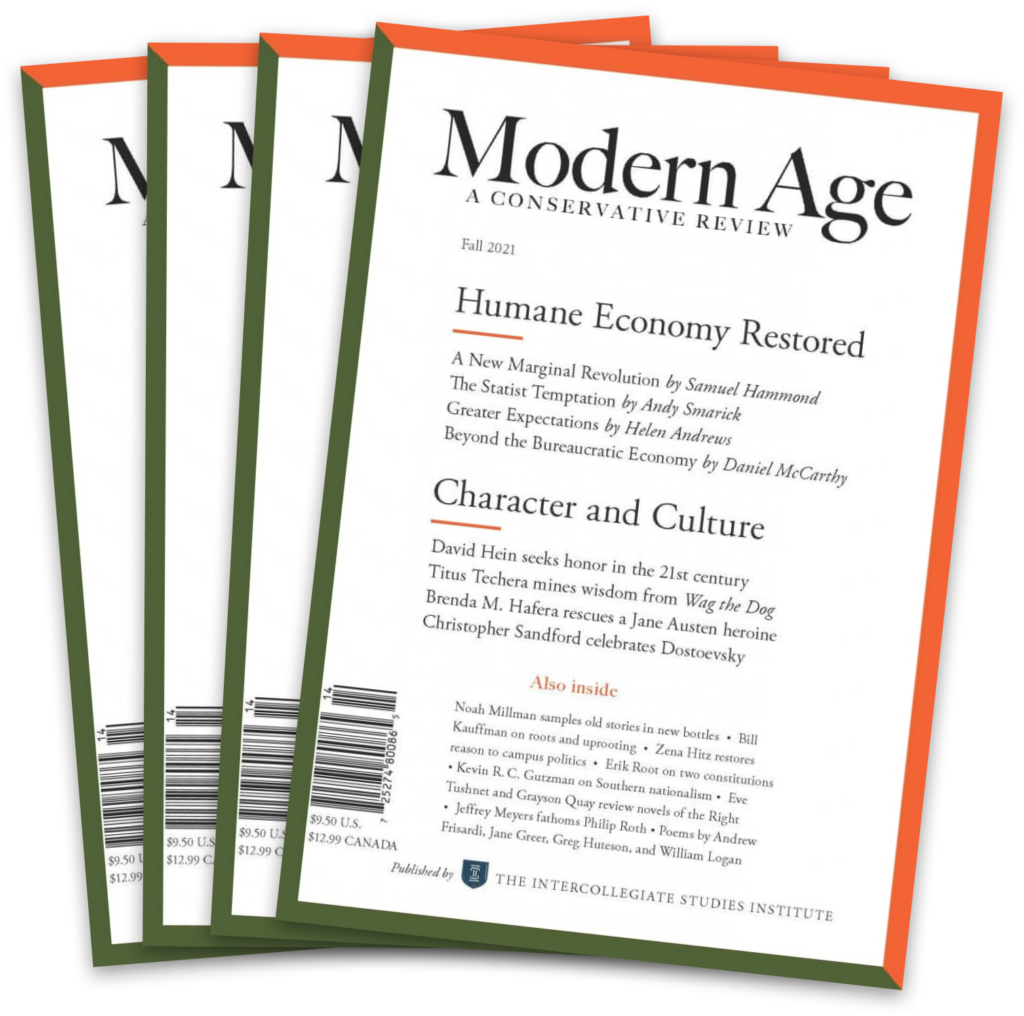Arguably the premier scholarly journal on the right since its founding in 1957 by conservative man of letters Russell Kirk, publisher Henry Regnery, and political scientist David S. Collier, Modern Age is intended, as Kirk wrote in its first editorial, “to stimulate discussion of the great moral and social and political and economic and literary questions of the hour, and to search for means by which the legacy of our civilization may be kept safe.” Published quarterly, the journal prints extensive, intellectually demanding essays by prominent thinkers. Kirk edited the journal for two years, then passed control to Eugene Davidson. While the magazine has always been both nonpartisan and nonsectarian, its editorial line has consistently remained conservative, and its pages have been especially open to people of faith. The journal has reflected on a broad range of issues, ranging from revolution, tradition, and totalitarian rule to the relationship between Western tradition and American liberty, the significance of literary movements such as the Fugitives and modernism, and the correct interpretation of the American Founding.
Over the years, contributors to the journal have included novelist John Dos Passos, conservative theoretician Frank Meyer, economist Ludwig von Mises, sociologist Robert Nisbet, political scientist Henry Jaffa, literary critic M. E. Bradford, novelist Andrew Lytle, political philosopher Francis Graham Wilson, Vatican II peritus John Courtney Murray, S.J., economist and social thinker Wilhelm Röpke, theologian Will Herberg, journalist William Henry Chamberlin, political philosophers Eric Voegelin and Eliseo Vivas, and literary critic Marion Montgomery.
The journal was published independently—on a frayed shoestring, insiders recall—for many years. Modern Age’s second editor (1960–69), Eugene Davidson, was a historian with a specialty in modern Germany. Under Davidson, Modern Age explored issues of individual liberty and resistance to Soviet expansion, working to diffuse the unearned prestige that Marxist theory had attained in academic circles. Modern Age offered serious, sustained theoretical explorations of the flaws inherent in socialisms of every variety and in doing so helped sustain a growing movement of resistance within the academy to the dominance of leftist thought. Memorable essays in this vein include the great libertarian Murray Rothbard’s “Freedom, Inequality, Primitivism, and the Division of Labor,” Herberg’s “Christian Faith and Totalitarian Rule,” and critic J. M. Lalley’s “Anatomy of Perdition.”
The journal’s third editor, David Collier, took over in 1969, as American intellectual life was torn over U.S. involvement in the Vietnam War. A political scientist, Collier published essays exploring the roots of the suddenly popular protest movements, such as “Marxism, Anarchism, and the New Left” by the German historian Karl A. Wittfogel, and “Marxist Revisionism: A Commentary,” by Molnar.
By the mid-1970s, the journal was facing financial trouble; with circulation hovering around 6,500, its future was in doubt. At the initiative of John Lulves, then executive vice president of the Intercollegiate Studies Institute, ISI approached Collier about a merger with Modern Age—to which it could offer fundraising and organizational expertise and a large base of student and faculty supporters. The merger took place in 1976, and the magazine’s circulation soon rose to exceed ten thousand. According to Lee Edwards, Modern Age’s “issues from 1976 to 1983 were marked by a concentration on ‘conservative theory’ at a time when the conservative movement was on the cusp of coming to political power. . . . There were, for example, a long string of articles about the relationship between libertarians, traditionalists, and the then-novel neoconservatives, by such authors as Robert Nisbet, Murray Rothbard, George Carey, Russell Kirk, and Paul Gottfried. The journal also devoted significant space to the important debate begun by M. E. Bradford and Harry Jaffa over the meaning of the “equality” favored by the American Founders—a debate that marked the beginning of the acrimonious, enduring split between traditionalists and neoconservatives.
When Collier died in 1984, there was some internal debate over which direction Modern Age ought to take—deeper into political theory, or more broadly into general culture. In the end, the magazine’s literary editor, George Panichas, was asked to lead the journal in the latter direction. In the decades since, Modern Age has become, in the words of one contributor, “the journal of moralist literary criticism.” One of the most important issues of the journal under Panichas’s tenure came in 1988, the winter issue of which featured a symposium of twelve leading thinkers on the right discussing the import of Allan Bloom’s Closing of the American Mind. While campus leftists had denounced Bloom as a reactionary, in Modern Age authors Stephen Tonsor, Marion Montgomery, Peter Augustine Lawler, and others argued that in fact Bloom was a rationalist partisan of the radical Enlightenment. This episode illustrates well how, ever since its founding, Modern Age has sought to keep in creative tension both the Greek and the Judeo-Christian elements of the Western tradition.
Further Reading
Lee Edwards, Educating for Liberty: The First Half-Century of the Intercollegiate Studies Institute
George H. Nash, The Conservative Intellectual Movement in America since 1945
George Panichas, Modern Age: The First 25 Years
This entry was originally published in American Conservatism: An Encyclopedia, pp. 578–580.














